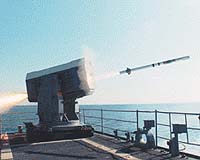 |
New Delhi (UPI) Jul 15, 2010 India has successfully test-fired an indigenously developed Astra air-to-air missile under poor weather conditions during the day and night. It was the first night test firing and also the first inclement weather launch, for an Astra, the missile's main development agency Defense Research and Development Organization said. The test from a launcher was conducted at the Integrated Test Range at Chandipur, around 140 miles from the Orissa state capital Bhubaneswar. Project Astra is part of India's indigenous Integrated Guided Missile Development Program initially developed more than 20 years ago. Other missiles produced or under development are the Agni, Prithvi, Trishul, Akash and Nag, as well as a cruise missile. Astra is India's first short-range air-to-air missile. The missile will augment the air force's other missiles, the French-made Matra Super 530D and the Russian-made AA-10 Alamo-C and AA-12 Adder. India also imports Israeli Python and Derby air-to-air missiles. The single-stage, short-range solid-fuel weapon is a beyond-visual-range missile designed to be highly maneuverable for seeking aerial targets at speeds of up to 1,064 miles an hour. The 12.5-foot long missile can carry a warhead weighing 33 pounds and can be fitted onto the military's Sukhoi-30 MKI, MiG-29, Mirage-2000, Jaguar and the Tejas light combat aircraft. Astra weighs around 340 pounds and has a range of around 50 miles head on or 12 miles for a tail chase. The operational ceiling is around 66,000 feet. DRDO began test firings of the Astra in May 2003 when it was launched without control and guidance systems. Testing of the dual-mode guidance systems -- inertial, mid-course update and terminal active radar homing -- was carried out successfully in May last year. The DRDO said Astra will be able to be launched from different altitudes but those alterations would affect the range. It will cover nearly 70 miles when launched from an altitude of just more than 9 miles but only 27 miles when fired from an altitude of 5 miles. At sea level the range is expected to be 13 miles. Active homing range will be nearly 16 miles. A longer range version, the Astra Mark 2, will have a 93-mile head on range with a tail chase range of 21 miles. The DRDO also is said to be looking at rocket/ramjet propulsion similar to that used in its Akash surface-to-air missile project. In April, DRDO said development work is underway on the Nirbhav, a 19-foot-long and 1.5-foot-wide sub-sonic cruise-type missile with a range of around 650 miles. Nirbhav, meaning "fearless" in Sanskrit, is being developed by Advanced Systems Laboratory, a division of the DRDO. It has an inertial navigational system, will reach 530 mph and is designed to deliver more than 20 types of warheads.
Share This Article With Planet Earth
Related Links Learn about missile defense at SpaceWar.com All about missiles at SpaceWar.com
 LaBarge Awarded $1.2 M For RAM Guided Missile Launch System
LaBarge Awarded $1.2 M For RAM Guided Missile Launch SystemSt. Louis MO (SPX) Jul 15, 2010 LaBarge, Inc. has received a $1.2 million contract from Raytheon Missile Systems to provide printed circuit card assemblies for the Rolling Airframe Missile (RAM) Guided Missile Weapon System. ''LaBarge has produced a variety of complex wiring harnesses for the RAM missile system for two decades. This new contract expands LaBarge's support of Raytheon's missile system to include electronic ... read more |
|
| The content herein, unless otherwise known to be public domain, are Copyright 1995-2010 - SpaceDaily. AFP and UPI Wire Stories are copyright Agence France-Presse and United Press International. ESA Portal Reports are copyright European Space Agency. All NASA sourced material is public domain. Additional copyrights may apply in whole or part to other bona fide parties. Advertising does not imply endorsement,agreement or approval of any opinions, statements or information provided by SpaceDaily on any Web page published or hosted by SpaceDaily. Privacy Statement |